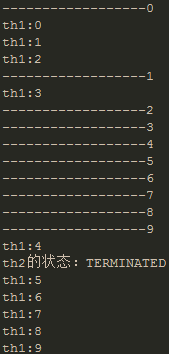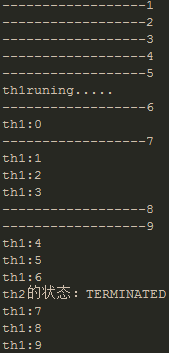多线程爬坑之路-Thread和Runable源码解析之基本方法的运用实例
前面的文章:多线程爬坑之路-学习多线程需要来了解哪些东西?(concurrent并发包的数据结构和线程池,Locks锁,Atomic原子类)
前面大致的了解了Thread的一些方法和属性下面对一些方法进行运用看看具体效果<下面可能还是会贴很多的源代码,其实我是拒绝的,我只想贴每个方法的代码,但是有时候看到一个方法里面有调用了方法,但是笔者有没有给出来,很蛋疼,有种爽到一半的感觉,所以我还是会把它贴出来,希望一次就能挖到底,不论有没有全懂,但至少懂了几分。>
activeCount():返回当前线程所属线程组的活动线程数
源代码如下:
/**
* Returns an estimate of the number of active threads in the current
* thread's {@linkplain java.lang.ThreadGroup thread group} and its
* subgroups. Recursively iterates over all subgroups in the current
* thread's thread group.
*
* <p> The value returned is only an estimate because the number of
* threads may change dynamically while this method traverses internal
* data structures, and might be affected by the presence of certain
* system threads. This method is intended primarily for debugging
* and monitoring purposes.
*
* @return an estimate of the number of active threads in the current
* thread's thread group and in any other thread group that
* has the current thread's thread group as an ancestor
*/
public static int activeCount() {
return currentThread().getThreadGroup().activeCount();
}
这个静态方法先调用了一个currentThread()方法获取当前线程,然后调用了getThreadgroup()获取线程组,最后调用了activeCount()方法获取活动线程数。下面是调用的方法的具体实现,native方法调用的是VM的实现,需要下载VM的源码才能查看,这里先略过。
/**
* Returns a reference to the currently executing thread object.
*
* @return the currently executing thread.
*/
public static native Thread currentThread(); /**
* Returns the thread group to which this thread belongs.
* This method returns null if this thread has died
* (been stopped).
*
* @return this thread's thread group.
*/
public final ThreadGroup getThreadGroup() {
return group;
} /**
* Returns an estimate of the number of active threads in this thread
* group and its subgroups. Recursively iterates over all subgroups in
* this thread group.
*
* <p> The value returned is only an estimate because the number of
* threads may change dynamically while this method traverses internal
* data structures, and might be affected by the presence of certain
* system threads. This method is intended primarily for debugging
* and monitoring purposes.
*
* @return an estimate of the number of active threads in this thread
* group and in any other thread group that has this thread
* group as an ancestor
*
* @since JDK1.0
*/
public int activeCount() {
int result;
// Snapshot sub-group data so we don't hold this lock
// while our children are computing.
int ngroupsSnapshot;
ThreadGroup[] groupsSnapshot;
synchronized (this) {
if (destroyed) {
return 0;
}
result = nthreads;
ngroupsSnapshot = ngroups;
if (groups != null) {
groupsSnapshot = Arrays.copyOf(groups, ngroupsSnapshot);
} else {
groupsSnapshot = null;
}
}
for (int i = 0 ; i < ngroupsSnapshot ; i++) {
result += groupsSnapshot[i].activeCount();
}
return result;
}
方法的使用:
/**
* thread method test
* @author Ljcx
*
*/
public class ThreadMethord implements Runnable{
@Override
public void run() {
System.out.println("");
try {
Thread.sleep(1000);
} catch (InterruptedException e) {
e.printStackTrace();
}
} public static void main(String[] args) {
ThreadMethord tm = new ThreadMethord();
Thread th = new Thread(tm);
th.start();
System.out.println("--活动线程数--"+th.activeCount());
ThreadMethord tm2 = new ThreadMethord();
Thread th2 = new Thread(tm2);
th2.start();
System.out.println("--活动线程数--"+th2.activeCount());
}
}
运行结果:
--活动线程数--2
--活动线程数--3
程序启动一共创建了三个线程:main,th,th2,主线程启动main函数,线程th启动,此时的活动线程为main,th.然后创建线程th2并启动。此时活动线程数是main,th,th2.把上面的代码稍微修改一下
public class ThreadMethord implements Runnable{
public void run() {
System.out.println("");
/*try {
Thread.sleep(1000);
} catch (InterruptedException e) {
e.printStackTrace();
}*/
}
public static void main(String[] args) {
ThreadMethord tm = new ThreadMethord();
Thread th = new Thread(tm);
th.start();
System.out.println("--活动线程数--"+th.activeCount());
ThreadMethord tm2 = new ThreadMethord();
Thread th2 = new Thread(tm2);
th2.start();
System.out.println("--活动线程数--"+th2.activeCount());
}
}
运行结果:
--活动线程数--2
--活动线程数--2
好像跟预期的结果不一样,只是因为把线程休眠去掉了,那是因为在th2启动的时候th1已经运行结束了。
基本属性的获取方法:
方法使用:
public class ThreadMethord implements Runnable{
public void run() {
System.out.println("");
System.out.println("-当前线程的引用--"+ Thread.currentThread());
try {
Thread.sleep(1000);
} catch (InterruptedException e) {
e.printStackTrace();
}
}
public static void main(String[] args) {
ThreadMethord tm = new ThreadMethord();
Thread th = new Thread(tm);
th.start();
System.out.println("--活动线程数--"+th.activeCount());
ThreadMethord tm2 = new ThreadMethord();
Thread th2 = new Thread(tm2);
th2.start();
System.out.println("--活动线程数--"+th2.activeCount());
Thread [] tarray = new Thread[3];
System.out.println("-当前线程的引用--"+ Thread.currentThread());
Thread.enumerate(tarray);//将当前线程的所有活动线程放进数组里
for (Thread thread : tarray) {
System.out.println("--tarray活动线程--"+thread);
}
System.out.println("--th线程ID--"+th.getId());
System.out.println("--th的线程名--"+ th.getName());
System.out.println("--th的线程优先级--"+ th.getPriority());
System.out.println("--th的线程组--"+ th.getThreadGroup());
System.out.println("--th2线程ID--"+th2.getId());
System.out.println("--th2的线程名--"+ th2.getName());
th2.setPriority(6);//设置优先级
System.out.println("--th2的线程优先级--"+ th2.getPriority());
System.out.println("--th2的线程组--"+ th2.getThreadGroup());
}
}
运行结果:
--活动线程数--2
--活动线程数--3
-当前线程的引用--Thread[main,5,main] --tarray活动线程--Thread[main,5,main]
--tarray活动线程--Thread[Thread-0,5,main]
--tarray活动线程--Thread[Thread-1,5,main] --th线程ID--10
--th的线程名--Thread-0
--th的线程优先级--5
--th的线程组--java.lang.ThreadGroup[name=main,maxpri=10]
--th2线程ID--11
--th2的线程名--Thread-1
--th2的线程优先级--6
--th2的线程组--java.lang.ThreadGroup[name=main,maxpri=10] -当前线程的引用--Thread[Thread-0,5,main]
-当前线程的引用--Thread[Thread-1,6,main]
可以看到主线程他的引用就是main,优先级是5,所属线程组是main,th和th2他们的引用分别是Thread-0,Thread-1,这是他们的线程名,因为我们在创建现成的时候没有个他初始化名称,所以默认使用Thread-加上线程组内线程创建的序号。(说多了我以为我在胡扯,来看一波源代码)
源代码:
//这个初始化方法是我们调用的,可以看到他的命名方式:“Thread-“+nextThreadNum(),这个nextThreadNum方法是一个同步的方法,加了
//sychnorized锁,返回的是一个私有的静态的int类型的属性,所以他的默认值应该是0,说到这有的小伙伴可能有疑问了,既然默认值(初始值)0,
//那么这里返回的是threadInitNumber++,那第一个线程名应该是Thread-1,问题又回到了++i和i++的问题了,不多说了。
public Thread(Runnable target) {
init(null, target, "Thread-" + nextThreadNum(), 0);
}
/*初始化方法的四个参数第一个线程组,第二个线程,第三个线程名,第四个是栈大小
private void init(ThreadGroup g, Runnable target, String name,long stackSize) {
init(g, target, name, stackSize, null);
}*/
private static int threadInitNumber;
private static synchronized int nextThreadNum() {
return threadInitNumber++;
}
getState():获取线程状态
方法使用:
public class TestMethord2 implements Runnable{
@Override
public void run() {
//获取当前线程的引用
Thread obj = Thread.currentThread();
System.out.println("线程:"+obj.getName()+"的状态:"+obj.getState());//RUNNABLE
try {
Thread.sleep(2000);
} catch (InterruptedException e) {
e.printStackTrace();
}
}
public static void main(String[] args) {
TestMethord2 t1 = new TestMethord2();
TestMethord2 t2 = new TestMethord2();
Thread th1 = new Thread(t1,"th1");
System.out.println(th1.getState());//NEW
th1.start();
System.out.println(th1.getState());//RUNNABLE
//等待线程执行到sleep
try {
Thread.sleep(1000);
} catch (InterruptedException e) {
e.printStackTrace();
}
System.out.println(th1.getState());//TIMES_WAITING
//等待线程th1执行完毕
try {
Thread.sleep(1000);
} catch (InterruptedException e) {
e.printStackTrace();
}
System.out.println(th1.getState());//TERMINATED
}
}
运行结果:(跑一下代码一目了然可以看到不同的状态)
线程th1的状态:NEW
线程th1的状态:RUNNABLE
RUN线程th1的状态:RUNNABLE
线程th1的状态:TIMED_WAITING
线程th1的状态:TERMINATED
开始创建的时候状态是:NEW。start之后线程执行,状态是RUNNABLE,此时主线程进入休眠1秒,是为了等待th1进入到休眠状态,当th1进入休眠状态2秒,主线程已经结束了休眠此时在查看th1的状态为TIMED_WAIING,我们再让主线程等待1秒,th1结束了休眠,执行完毕,再次查看th1状态为TERMINATED。
跟状态相关的方法:
yield:暂停当前线程,让其他线程先执行。
public class TestMethord3 implements Runnable{
@Override
public void run() {
System.out.println(Thread.currentThread().getName()+"runing.....");
for (int i = 0; i <10; i++) {
System.out.println(Thread.currentThread().getName()+":"+i);
if(i==3){
Thread.yield();
}
}
}
public static void main(String[] args) {
TestMethord3 tm1 = new TestMethord3();
TestMethord3_2 tm2 = new TestMethord3_2();
Thread th1 = new Thread(tm1, "th1");
Thread th2 = new Thread(tm2, "th2");
th1.start();
th2.start();
}
}
public class TestMethord3_2 implements Runnable{
public void run() {
System.out.println(Thread.currentThread().getName()+"runing.....");
for (int i = 0; i < 10; i++) {
System.out.println("------------------"+i);
}
}
}
运行结果:这个结果每次运行都不一样。
th2runing.....
th1runing.....
------------------0
------------------1
------------------2
------------------3
------------------4
------------------5
------------------6
th1:0
------------------7
th1:1
------------------8
------------------9
th1:2
th1:3
th1:4
th1:5
th1:6
th1:7
th1:8
th1:9
按照理想上来说,我们在th1运行到输出3的时候就应该停下来让th2先执行完,th1和th2是我交叉执行应该只发生在th1输出3之前。然而结果并不是如此,多运行几次就会发现,这个yield方法并没有起到应有的作用,这是由于CPU资源充足的情况下两个都能获取到CPU,暂停当前线程的执行可能只是在CPU资源不足的情况下让出CPU资源。(个人理解),但是就算是CPU资源不充足,两个同等优先级的线程在一个暂停之后仍然有同等几率被调度选中分配到资源,所以说这个yield方法同等优先级的情况下出现不管用的几率会更大。
join:等待某线程终止
public class TestMethord3 implements Runnable{
public void run() {
System.out.println(Thread.currentThread().getName()+"runing.....");
for (int i = 0; i <10; i++) {
System.out.println(Thread.currentThread().getName()+":"+i);
if(i==3){
Thread.yield();
}
}
}
public static void main(String[] args) throws InterruptedException {
TestMethord3 tm1 = new TestMethord3();
TestMethord3_2 tm2 = new TestMethord3_2();
Thread th1 = new Thread(tm1, "th1");
Thread th2 = new Thread(tm2, "th2");
th1.start();
th2.start();
th2.join();
System.out.println("th2的状态:"+th2.getState());
}
}
public class TestMethord3_2 implements Runnable{
public void run() {
System.out.println(Thread.currentThread().getName()+"runing.....");
for (int i = 0; i < 10; i++) {
System.out.println("------------------"+i);
}
}
}
运行结果:下面是运行四次的结果显示,从结果中可以看出,无论th1,th2怎么运行,最终主线程输出的th2的状态都是TERMINATED,因为这一行输出是放在th2.join()后面的,表示的是主线程要等待th2执行完毕才能继续执行。




wait(),wait(long million),notify(),notifyAll(),这几个方法继承自Object类.
wait()和wait(long million):指的是让线程等待,与sleep的不同的是,wait方法会释放CPU,而sleep仍然占有CPU资源。
notify():指的是唤醒某个线程
notifyAll() :指的是唤醒所有的线程
这几个方法需要组合使用,在多个线程运行时涉及到的先后问题,暂时还未研究深入,先放一下。后面会补充上。
通过上面这些方法,基本上了解了线程这个类。除去基本的属性方法,其他的跟状态相关的在复杂的并发线程环境中才能体现他们的作用和价值,也才能展现出使用上的难度,这里所涉及到的不过是九牛一毛,后面继续探索。
多线程爬坑之路-Thread和Runable源码解析之基本方法的运用实例的更多相关文章
- 多线程爬坑之路-Thread和Runable源码解析
多线程:(百度百科借一波定义) 多线程(英语:multithreading),是指从软件或者硬件上实现多个线程并发执行的技术.具有多线程能力的计算机因有硬件支持而能够在同一时间执行多于一个线程,进而提 ...
- [Java多线程]-Thread和Runable源码解析之基本方法的运用实例
前面的文章:多线程爬坑之路-学习多线程需要来了解哪些东西?(concurrent并发包的数据结构和线程池,Locks锁,Atomic原子类) 多线程爬坑之路-Thread和Runable源码解析 前面 ...
- [Java多线程]-Thread和Runable源码解析
多线程:(百度百科借一波定义) 多线程(英语:multithreading),是指从软件或者硬件上实现多个线程并发执行的技术.具有多线程能力的计算机因有硬件支持而能够在同一时间执行多于一个线程,进而提 ...
- [Java多线程]-线程池的基本使用和部分源码解析(创建,执行原理)
前面的文章:多线程爬坑之路-学习多线程需要来了解哪些东西?(concurrent并发包的数据结构和线程池,Locks锁,Atomic原子类) 多线程爬坑之路-Thread和Runable源码解析 多线 ...
- 多线程爬坑之路-学习多线程需要来了解哪些东西?(concurrent并发包的数据结构和线程池,Locks锁,Atomic原子类)
前言:刚学习了一段机器学习,最近需要重构一个java项目,又赶过来看java.大多是线程代码,没办法,那时候总觉得多线程是个很难的部分很少用到,所以一直没下决定去啃,那些年留下的坑,总是得自己跳进去填 ...
- 多线程爬坑之路-ThreadLocal源码及原理的深入分析
ThreadLocal<T>类:以空间换时间提供一种多线程更快捷访问变量的方式.这种方式不存在竞争,所以也不存在并发的安全性问题. This class provides thread-l ...
- 多线程爬坑之路-J.U.C.atomic包下的AtomicInteger,AtomicLong等类的源码解析
Atomic原子类:为基本类型的封装类Boolean,Integer,Long,对象引用等提供原子操作. 一.Atomic包下的所有类如下表: 类摘要 AtomicBoolean 可以用原子方式更新的 ...
- Thread、ThreadLocal源码解析
今天来看一下Thread和ThreadLocal类的源码. 一.Thread (1)首先看一下线程的构造方法,之后会说每种参数的用法,而所有的构造函数都会指向init方法 //空构造创建一个线程 Th ...
- 多线程爬坑之路--并发,并行,synchonrized同步的用法
一.多线程的并发与并行: 并发:多个线程同时都处在运行中的状态.线程之间相互干扰,存在竞争,(CPU,缓冲区),每个线程轮流使用CPU,当一个线程占有CPU时,其他线程处于挂起状态,各线程断续推进. ...
随机推荐
- 继电器是如何成为CPU的(1)
继电器是如何成为CPU的(1) ——<穿越计算机的迷雾>整理和总结 究竟是如何设计的电路,具有计算和控制的智力? 这一点也不高深.本系列文章从初中学的最简单的电路图说起,看看能不能从最初的 ...
- android http 抓包
有时候想开发的时候想看APP发出的http请求和响应是什么,这就需要抓包了,这可以得到一些不为人知的api,比如还可以干些“坏事”... 需要工具: Fiddler2 抓包(点击下载) Android ...
- 开始学nodejs——net模块
net模块的组成部分 详见 http://nodejs.cn/api/net.html 下面整理出了整个net模块的知识结构,和各个事件.方法.属性的用法 net.Server类 net.Socket ...
- Mac OS、Ubuntu 安装及使用 Consul
Consul 概念(摘录): Consul 是 HashiCorp 公司推出的开源工具,用于实现分布式系统的服务发现与配置.与其他分布式服务注册与发现的方案,比如 Airbnb 的 SmartStac ...
- vue入门学习(基础篇)
vue入门学习总结: vue的一个组件包括三部分:template.style.script. vue的数据在data中定义使用. 数据渲染指令:v-text.v-html.{{}}. 隐藏未编译的标 ...
- linux centos中添加删除修改环境变量,设置java环境变量
前言 安装完软件必要添加环境变量.指令很少,然而长时间不写就会不自信:我写的对吗?于是百度开始,于是发现又是各有千秋.好吧,好记星不如烂笔头.当然,最重要的是,百度出来的都他妈的是如何添加环境变量,只 ...
- css3圆形百分比进度条的实现原理
原文地址:css3圆形百分比进度条的实现原理 今天早上起来在查看jquery插件机制的时候,一不小心点进了css3圆形百分比进度条的相关文章,于是一发不可收拾,开始折腾了... 关于圆形圈的实现,想必 ...
- Twproject Gantt开源甘特图功能扩展
1.Twproject Gantt甘特图介绍 Twproject Gantt 是一款基于 jQuery 开发的甘特图组件,也可以创建其它图表,例如任务树(Task Trees).内置编辑.缩放和 CS ...
- 在你的ASP.NET MVC中使用查找功能
在程序中,使用查找功能是少之不了.今天在ASP.NET环境下演示一回. 在cshtml视图中,有三个文本框,让用户输入关键词,然后点击最右连的“搜索”铵钮,如果有结果将显示于下面. Html: 表格放 ...
- 【微信小程序开发】之如何获取免费ssl证书【图文步骤】
微信小程序要求所有网络请求都走ssl加密,因此我们开发服务端接口需要配置为https 这篇文章介绍一下如何 在 startssl 申请一个免费的ca证书. 1. 打开网站 https://www.s ...
